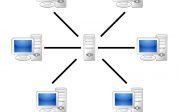What is Electronic Mail (email)?
Email:
Email is a system for delivering messages over the Internet. An e-mail sender or recipient can be anywhere in the world. E-mail is the first really popular internet application; it allows people to hold discussions over great distances. It can be sent to anywhere in the world to anyone who uses the Internet. E-mail can take as little as few seconds to go across a country, or even around the world. It leaves a written record. You can keep copies of e-mail messages you send and receive, for your record. One message can be send to a number of people. Pictures, documents and other computer files can also be sent along with the message.
How to send and receive e-mail?
To create, send and receive email you need email-program, also called email client. Once you send the message, your computer connects to your email server and transmits a copy of your message. Email Server is a host computer on the Internet which keeps track of information about millions of email account holders. The server checks the address you have typed and figures out where the recipient email server is. It connects to that server and transmits another copy of the message. Once the receiving email server has received the message, the recipient is able to retrieve the message when connected to the server. Attachment is a powerful feature of email, which enables you to enclosed additional files with your email. You can attach work processing documents, spreadsheets, programs, images, even audio, to your email messages when using email programs that support the Internet protocol for multimedia attachments i.e. MIME (Multipurpose Internet Mail Extension). Most email clients allow you attach files to the message. In this way you can send and receive data as well as program files. Attachment size varies from one email service provider to the other e.g. for free email accounts; Yahoo allows a file of size up to 10 MB to be attached. This limit varies for paid accounts.
Limitations of Email:
There are some shortcomings or limitations of email. Some of them are as follows:-
(1) Email is not necessarily private
Since messages are passed from one system to another, and sometimes through several systems or networks, there are many opportunities for someone to intercept or read email. Many types of computer systems have protections built in to stop users from reading others’ email, but it is still possible for a system administrator to read the email on a system or for someone to bypass the security of a computer system.
(2) Some email systems can send or receive text files only
Even though you can send and receive images, programs, files produces by word processing programs, or multimedia messages, some individuals may not be able to properly view your message.
(3) It is possible to forge email:
This is not common, but it is possible to forge the address of the sender. You may want to take steps to confirm the source of some email you receive.
(4) It is difficult to express emotion using email
The recipient does not have the benefit of viewing your facial expressions or hearing your voice. You have to be careful with humor or irony, since it is easy for someone to take your message the wrong way.
(5) You can receive too much or unwanted emails
You can receive “junk” email in the same way you receive other types of junk mail. On the Internet, junk mail is called spam. You may have to take active steps to delete the email you receive and try to stop it from being sent to you in the first place.
(6) You may not know about the person with whom you are communicating
The communication is often in text and it is possible for us to get an incorrect impression of the person sending us email Also, some people misrepresent themselves.
Email Address:
To send and receive an email, you must have an email account on an email server. When you open an email account, you are assigned a unique email address. You receive all incoming emails on this account address and send email to others by specifying their email addresses. The general format of an email address is:
User name @ DNS address
For example, nazakat@gmail.com (nazakat specify the user name whereas the second apart after @ symbol specify the DNS address.




